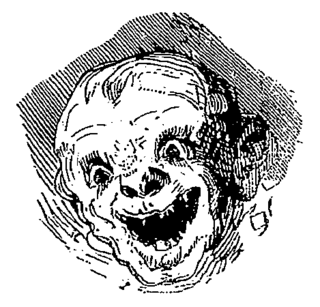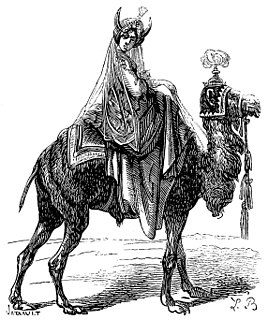
Bael is a demon described in demonological grimoires such as the Lesser Key of Solomon and the Pseudomonarchia Daemonum and also described in the Dictionnaire Infernal. He is described as a hoarsely-voiced king with the power to make men invisible and ruling over sixty-six legions of demons. The Lesser Key of Solomon describes him as appearing in the form of a cat, toad, man, some combination thereof, or other "divers [sic] shapes," while the Pseudomonarchia Daemonum and the Dictionnaire Infernal state that he appears with the heads of a cat, toad, and human simultaneously. Colin de Plancy wonders if Bael is the same as the Canaanite deity Baal, a reasonable conclusion. In the Livre des Esperitz, Bael is described as a king ruled by Orient (Oriens), still possessing the power of invisibility, as well as the power to garner the favor of others, but ruling over only six legions of demons. The Liber Officium Spirituum features Baal, Baall, Boal, or Boall, again a hoarsely-voiced king, with not only powers of invisibility but also sciences and love. Sloane MS 3824 mentions Baal, in "Of the Demon Rulers," as a king ruled by Oriens, attributed with teaching science, (again) granting invisibility, and controlling 250 legions of spirits. Bael appears in later editions of the Grimoire of Pope Honorius, under Astaroth, as a prince whose powers include (again) invisibility and popularity. In the Grand Grimoire, Bael is listed as a subordinate of Lucifuge Rofocale. According to Rudd, Bael is opposed by the Shemhamphorasch angel Vehuiah.

Alloces is a demon that appears in demonological grimoires such as the Liber Officiorum Spirituum, Pseudomonarchia Daemonum, and the Lesser Key of Solomon. He is described in the Lesser Key of Solomon and in the Pseudomonarchia Daemonum as a duke, taking the form of a fire-breathing, lion-headed soldier riding a horse. His purported duties include teaching astronomy and liberal sciences, and granting familiars. He is claimed to have 36 legions of demons under his command. In the Liber Officiorum Spirituum, Alloces appears as Allogor or Algor, again a duke, but otherwise with a completely different appearance and abilities -- a spear-toting knight who answers questions, provides advice for plans, and commands only 30 legions of demons. In duplicate entry, Alloces appears as Algor, ruled by the spirit "Orience" (Oriens), again as a knight who explains secrets, but with the additional power of garnering the favor of nobles. According to Rudd, Allocer is opposed by the Shemhamphorasch angel Imamiah.
Vine is a demon listed in demonological grimoires such the Lesser Key of Solomon Johann Weyer's Pseudomonarchia Daemonum, and Jacques Collin de Plancy's Dictionnaire Infernal.

Bifrons is a demon described in the demonological grimoires the Lesser Key of Solomon and the Pseudomonarchia Daemonum, as well as being mentioned in the Dictionnaire Infernal. In these works, he is described as an earl who initially appears as a monster before adopting a more human form. His duties include teaching arts and sciences, including astrology, geometry, and the properties of different plants and stones. He also moves bodies into different graves, lights candles over graves, and commands either 6, 26, or 60 legions of spirits. According to Rudd, Bifrons is opposed by the Shemhamphorasch angel Ariel.
The Lesser Key of Solomon, also known as Clavicula Salomonis Regis or Lemegeton, is an anonymous grimoire on demonology. It was compiled in the mid-17th century, mostly from materials a couple of centuries older. It is divided into five books—the Ars Goetia, Ars Theurgia-Goetia, Ars Paulina, Ars Almadel, and Ars Notoria.

Agares is a demon described in demonological grimoires.
In demonology, Halphas is the thirty-eighth demon in the Ars Goetia in the Lesser Key of Solomon, ranked as an earl.
Pseudomonarchia Daemonum, or False Monarchy of Demons, first appears as an Appendix to Johann Weyer's De praestigiis daemonum (1577).
Vassago is a demon described in demonological grimoires such as the Lesser Key of Solomon and the Book of the Office of Spirits.
Bathin is a demon described in demonological grimoires.
Bune is a demon listed in demonological grimoires such the Lesser Key of Solomon Johann Weyer's Pseudomonarchia Daemonum, Jacques Collin de Plancy's Dictionnaire Infernal, and the Livre des Esperitz.
Gamigin is a demon described in demonological grimoires such as The Lesser Key of Solomon and Johann Weyer's Pseudomonarchia Daemonum.

King Paimon is a spirit named in the Lesser Key of Solomon, Johann Weyer's Pseudomonarchia Daemonum, Collin de Plancy's Dictionnaire Infernal, the Livre des Esperitz, the Liber Officiorum Spirituum, The Book of Abramelin, and certain French editions of The Grimoire of Pope Honorius ; as well as British Library, Sloane MS 3824.
Leraye is a demon mentioned in demonological grimoires. He appears in the Lesser Key of Solomon, Johann Weyer's Pseudomonarchia Daemonum, and Jacques Collin de Plancy's Dictionnaire Infernal.
Botis, sometimes Otis, is a demon described in the Lesser Key of Solomon and the Pseudomonarchia Daemonum as a President and an Earl who initially appears as a viper before changing into a sword-toting, fanged, and horned human who discusses matters past, present, and future; brings favor from allies and enemies, and rules 60 legions of demons. In the Munich Manual of Demonic Magic, Botis appears as Otius, and is mostly identical except that he is a preses and Count, appears in the more humanoid form to begin with, and rules only 36 legions of demons. In the Grand Grimoire, Botis appears as a subordinate of Agaliarept. According to Rudd, Botis is opposed by the Shemhamphorasch angel Lauviah.

Gaap is a demon described in demonological grimoires such as the Lesser Key of Solomon, Johann Weyer's Pseudomonarchia Daemonum, and the Munich Manual of Demonic Magic, as well as Jacques Collin de Plancy's Dictionnaire Infernal,

Gemory is a demon listed in demonological grimoires.

Valac is a demon described in the goetic grimoires the Lesser Key of Solomon, Johann Weyer's Pseudomonarchia Daemonum, the Liber Officiorum Spirituum, and in the Munich Manual of Demonic Magic as an angelically winged boy riding a two-headed dragon, attributed with the power of finding treasures.
Amy or Amii is a demon described in demonological grimoires such as the Lesser Key of Solomon, the Pseudomonarchia Daemonum, and in the Munich Manual of Demonic Magic; as well as Jacques Collin de Plancy Dictionnaire Infernal,
Liber Officiorum Spirituum was a demonological grimoire and a major source for Johann Weyer's Pseudomonarchia Daemonum and the Ars Goetia. The original work has not been located, but some derived texts bearing the title have been found, some in the Sloane manuscripts, some in the Folger Shakespeare Library. Each version bears many similarities to each other and to the Pseudomonarchia Daemonum and the Ars Goetia, though they are far from identical.








